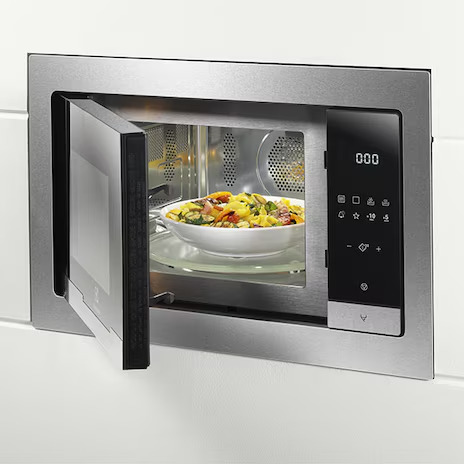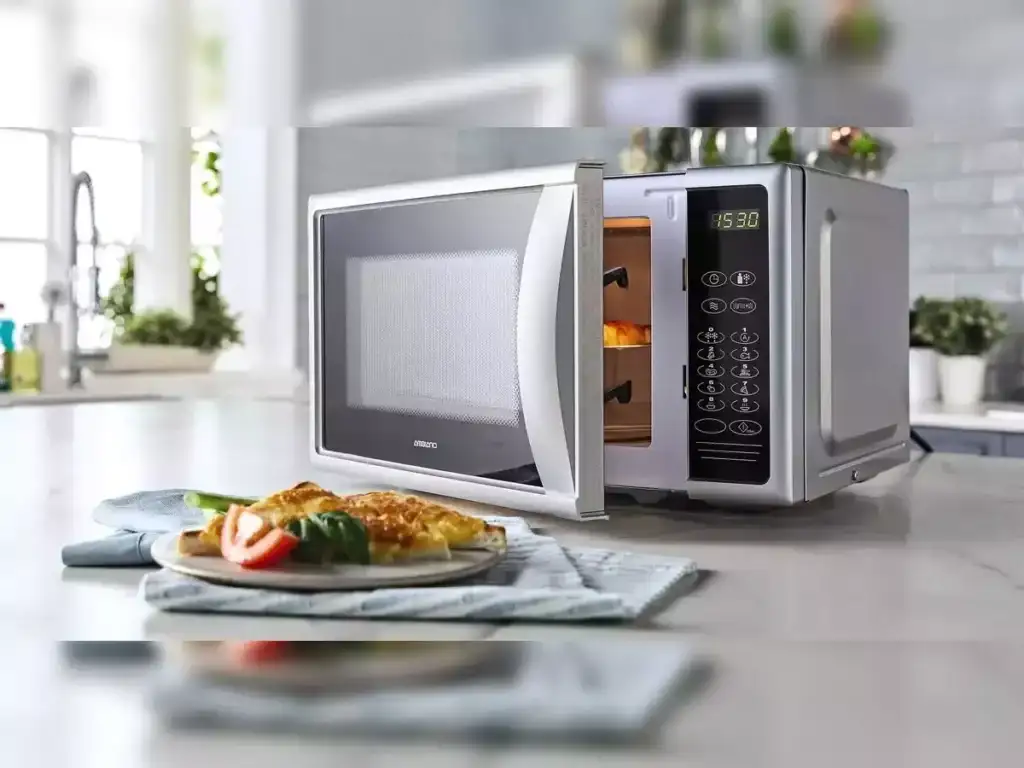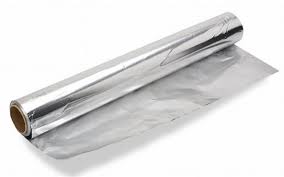


Microwave ovens can cook unevenly and leave “cold spots” where harmful bacteria can survive. For this reason, it is important to use a food thermometer and test food in several places to be sure it has reached the recommended safe temperature to destroy bacteria and other pathogens that could cause foodborne illness.
Foods best to cook on high power are basically tender foods and those with a high moisture content such as ground beef, poultry, vegetables and fruits. Eggs, cheese and solid meat can toughen when microwaved on high. They are best cooked on reduced power. Large cuts of meat should be cooked on medium power (50%) for longer periods. This allows heat to reach the center without overcooking outer areas.
Never partially cook food and store it for later use because any bacteria present wouldn’t have been destroyed. When partially cooking food in the microwave oven to finish cooking on the grill or in a conventional oven, it is important to transfer the microwaved food to the other heat source immediately.
Cooking whole, stuffed poultry in a microwave oven is not recommended. Because food cooks so quickly in a microwave oven, the stuffing might not have enough time to reach the temperature needed to destroy harmful bacteria.
Remove food from its packaging before defrosting. Do not use foam trays and plastic wraps because they are not heat stable at high temperatures. Melting or warping from the heat of the food may cause harmful chemicals to migrate into it.
How do you safely reheat cooked food in a microwave oven?
- Cover foods with a lid or a microwave-safe plastic wrap to hold in moisture and provide safe, even heating. Turn back a corner for the steam to vent.
- Heat ready-to-eat foods such as hot dogs, luncheon meats, fully cooked ham, and leftovers until steaming hot.
- After reheating foods in the microwave oven, allow standing time. Then, use a clean food thermometer to check that food has reached 165 °F.
SAFE TO USE cookware :
- Any utensil labeled for microwave use.
- Heatproof glass (such as Pyrex, Anchor Hocking, etc.).
- Glass-ceramic (such as Corning Ware).
- Oven cooking bags.
- Baskets (straw and wood) for quick warm-ups of rolls or bread. Line the basket with napkins to absorb moisture from food.
- Most paper plates, towels, napkins and bags. For optimal safety use white, unprinted materials.
- Wax paper, parchment paper, heavy plastic wrap. Do not allow plastic wrap to touch food; vent it to allow a steam escape.
- Heat-susceptor packaging.
NOT SAFE TO USE:
- Cold storage containers: margarine tubs, cottage cheese and yogurt cartons, etc. These materials are not approved for cooking and chemicals can migrate into food.
- Brown paper bags and newspapers.
- Metal pans.
- Foam-insulated cups, bowls, plates or trays.
- China with metallic paint or trim.
- Chinese “take-out” containers with metal handles.
- Metal “twist ties” on package wrapping.
- Food completely wrapped in aluminum foil.
- Food cooked in any container or packaging that has warped or melted during heating.
General Rules for Safe Use of Aluminum Foil:


- Use new, smooth foil only. Wrinkled foil can cause arcing (sparks).
- Cover no more than 1/4 of the food with foil.
- Shape the foil smoothly to the food so no edges stick out.
- It makes no difference which side of foil (shiny or dull) is facing out.
- Do not place the foil closer than one inch from the oven walls.
- If the microwave oven has metal shelves OR a metal turntable, don’t microwave food in foil containers or metal pans, and don’t let foil used for shielding touch or be close to the shelves or turntable.
- If you see arcing (sparks), immediately remove the foil shielding; transfer frozen food from foil container to a microwave-safe utensil.
How do you determine if a utensil is safe to use in a microwave oven?
Put one cup of tap water in a glass measure. Place the water in the microwave oven along with (but not touching) the utensil to be tested. Microwave on high 1 minute. If the utensil feels warm or hot, it is not microwave safe because it contains metal in the material or glaze. Do not use it. The utensil and/or the bottom of the oven might crack if microwaved.
Time-to-Boil Test
Measure a cup of water in a 2-cup glass measure. Add ice cubes; stir until water is ice cold. Discard ice cubes and pour out any water more than 1 cup. Set the microwave on high 4 minutes, but watch the water through the window to see when it boils.
- If water boils in less than 2 minutes, it is a very high wattage oven 1000 watts or more.
- If water boils in 2½ minutes, it is a high wattage oven about 800 watts or more.
- If water boils in 3 minutes, it is an average wattage oven 650 to 700 watts or more.
- If water boils in more than 3 minutes or not by 4 minutes, it is a slow oven 300 to 500 watts.
Do microwaves make food “radioactive”?
No. Microwave energy uses a wave length similar to television, radio waves, electric shavers and radar. It does not make food “radioactive.” X-rays and nuclear radiation are at the other end of the spectrum and are a million times more powerful.
Do not use the microwave for home canning or sterilizing jars. Use a water-bath or pressure canner, and approved canning jars and lids. At one time, “canners” were developed for use in the microwave; however these did not produce a safe product and are no longer manufactured.
clean the inside of a microwave oven
Consult the manufacturer’s use and care manual for the best advice for your model of microwave oven. Some manufacturers recommend unplugging the microwave before cleaning it to minimize the possibility of electric shock. If you can’t locate the manual, follow these general instructions.
- Remove spatters and spills as they occur so food residue won’t become dried on.
- Wipe with a soft cloth or clean paper towel dampened with warm water.
- For heavier soil, use baking soda, a mild soap, or dishwashing liquid.
- Do not use steel wool, scouring pads, abrasive cleaners, or oven cleaners.
- To remove food odors or loosen baked-on food residue, mix 6 tablespoons of baking soda OR 1/2 cup lemon juice with one cup of water in a microwave-safe glass measure. Microwave the mixture until it boils. Then leave the mixture in the microwave without opening the door until the mixture cools. The steam will help loosen food residue and remove odors. Wipe the surfaces with a soft cloth or paper towel.
